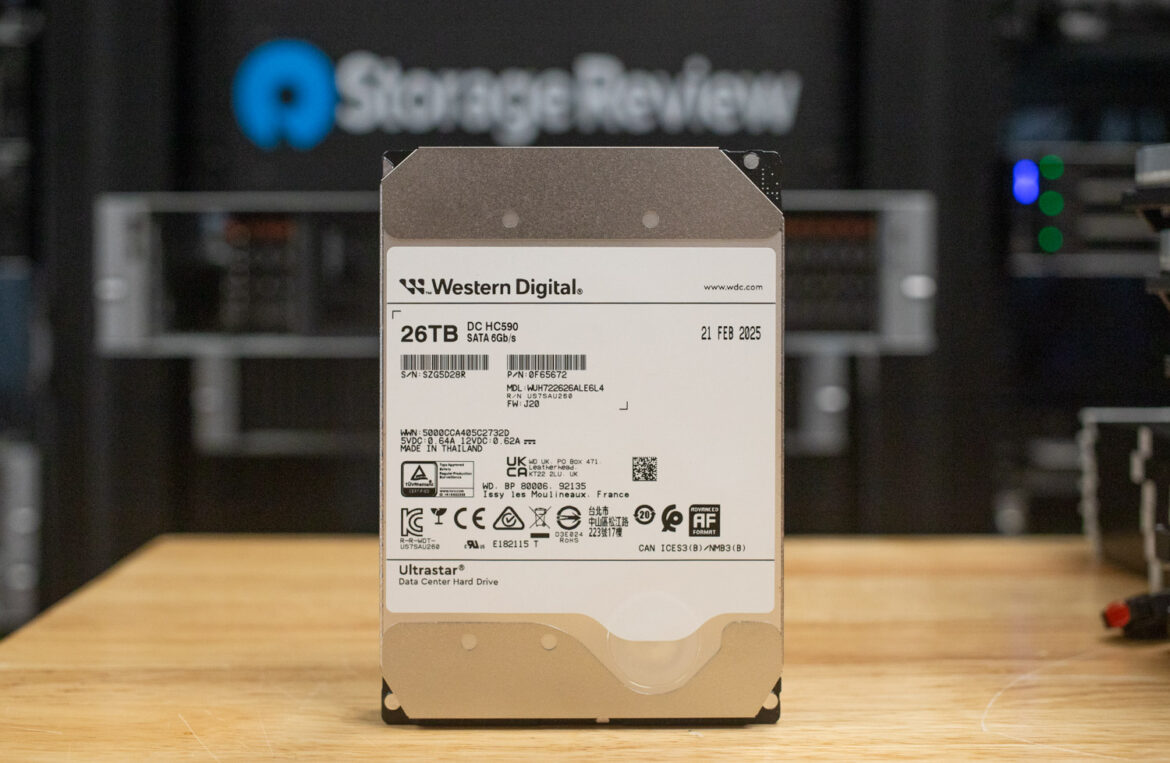Western Digital Ultrastar DC HC590’s CMR 11-platter design delivers higher raw capacity without any modifications to existing infrastructure.
The Western Digital Ultrastar DC HC590 is WD’s latest high-capacity enterprise hard drive, delivering up to 26TB of storage using conventional magnetic recording (CMR) in a standard 3.5-inch form factor. It’s the first CMR-based HDD to utilize an 11-platter design, enabling higher raw capacity without requiring modifications to existing infrastructure. This allows enterprise and hyperscale environments to scale storage density within the same physical and thermal footprint, preserving compatibility with current rack designs and enclosures. Ultimately, the HC590 is geared toward storage-intensive, read-focused workloads where reliability and cost efficiency matter more than peak performance.
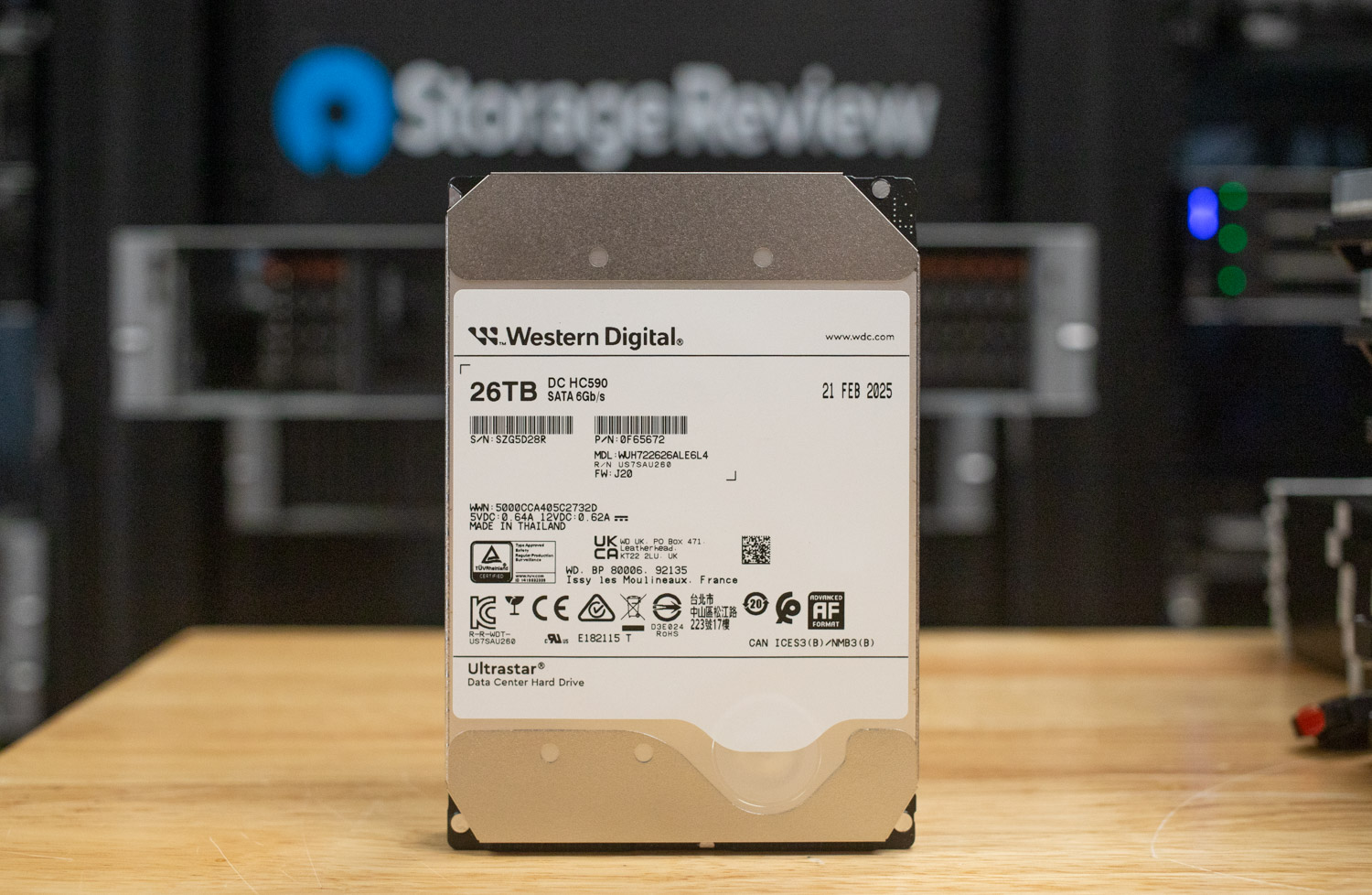
WD Ultrastar DC HC590 Features
The HC590 features familiar reliability-focused characteristics typical of this drive class, designed to maintain consistent performance in densely packed, vibration-prone deployments. This includes pairing energy-assisted PMR (ePMR) with its OptiNAND architecture, which incorporates embedded flash (iNAND) to offload internal tasks like metadata handling. Together, these technologies help boost areal density and reduce strain on the magnetic media, which can improve efficiency and throughput during large-scale sequential or metadata-heavy operations.
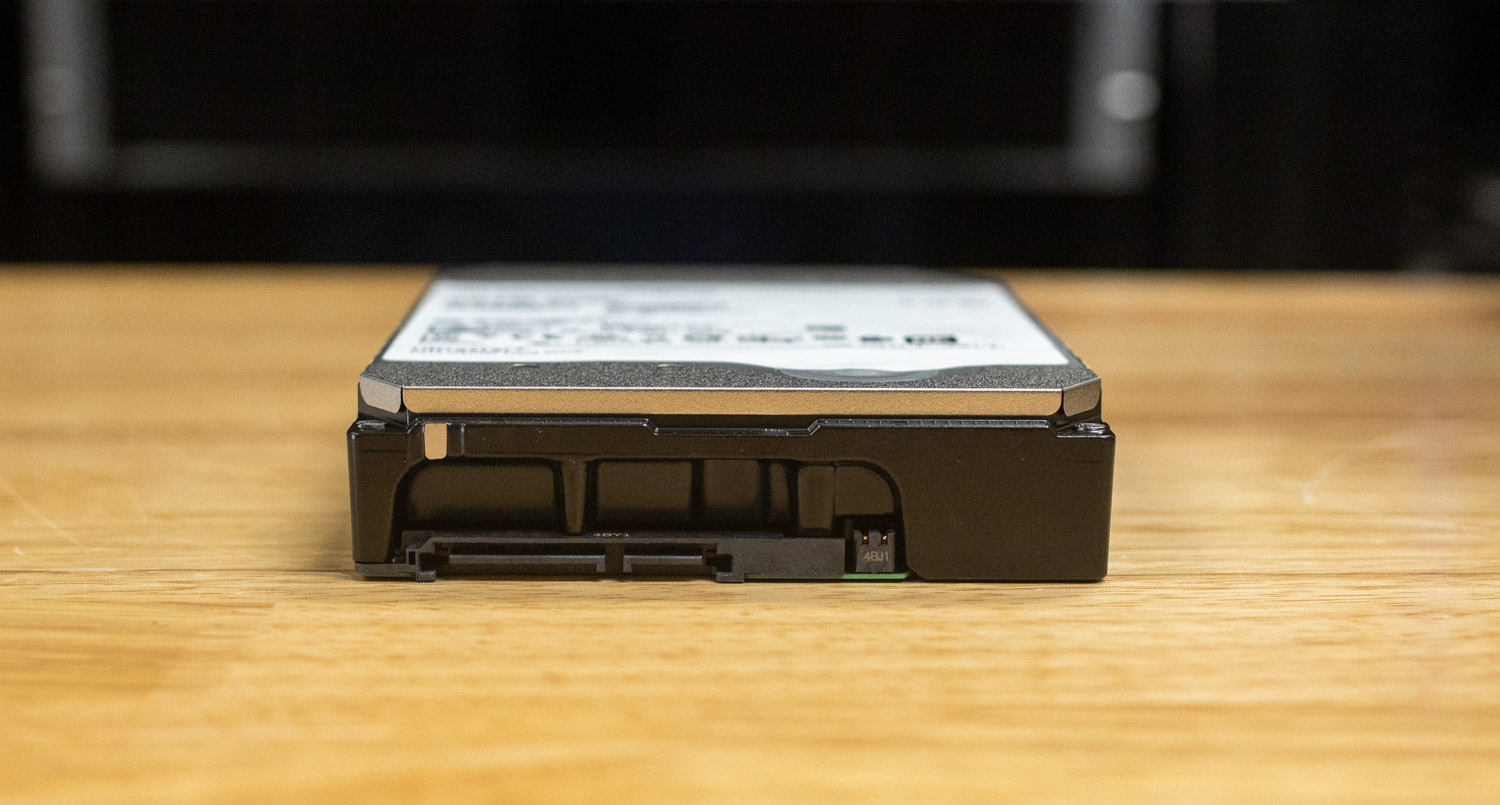
To help ensure stable performance in dense server racks, the drive also features Rotational Vibration Safeguard (RVS), which uses dual sensors to detect and compensate for environmental vibration. It also integrates Dynamic Fly Height (DFH), which adjusts the read/write head on the fly for improved contact accuracy. The helium-sealed enclosure reduces internal resistance and power consumption compared to air-filled alternatives.
ArmorCache is also available, allowing users to select either write cache disabled (WCD) mode for improved random write performance or write cache enabled (WCE) mode for cache data protection in power-loss scenarios. This is particularly useful in systems where the caching policy is governed by data integrity or throughput requirements.
As far as reliability goes, the drive is rated for 2.5 million hours MTBF and comes with a 5-year limited warranty, both of which are typical for enterprise-class drives. The HC590 comes in both SAS and SATA versions, with capacities of 24TB and 26TB. For this review, we tested the 26TB SATA model.
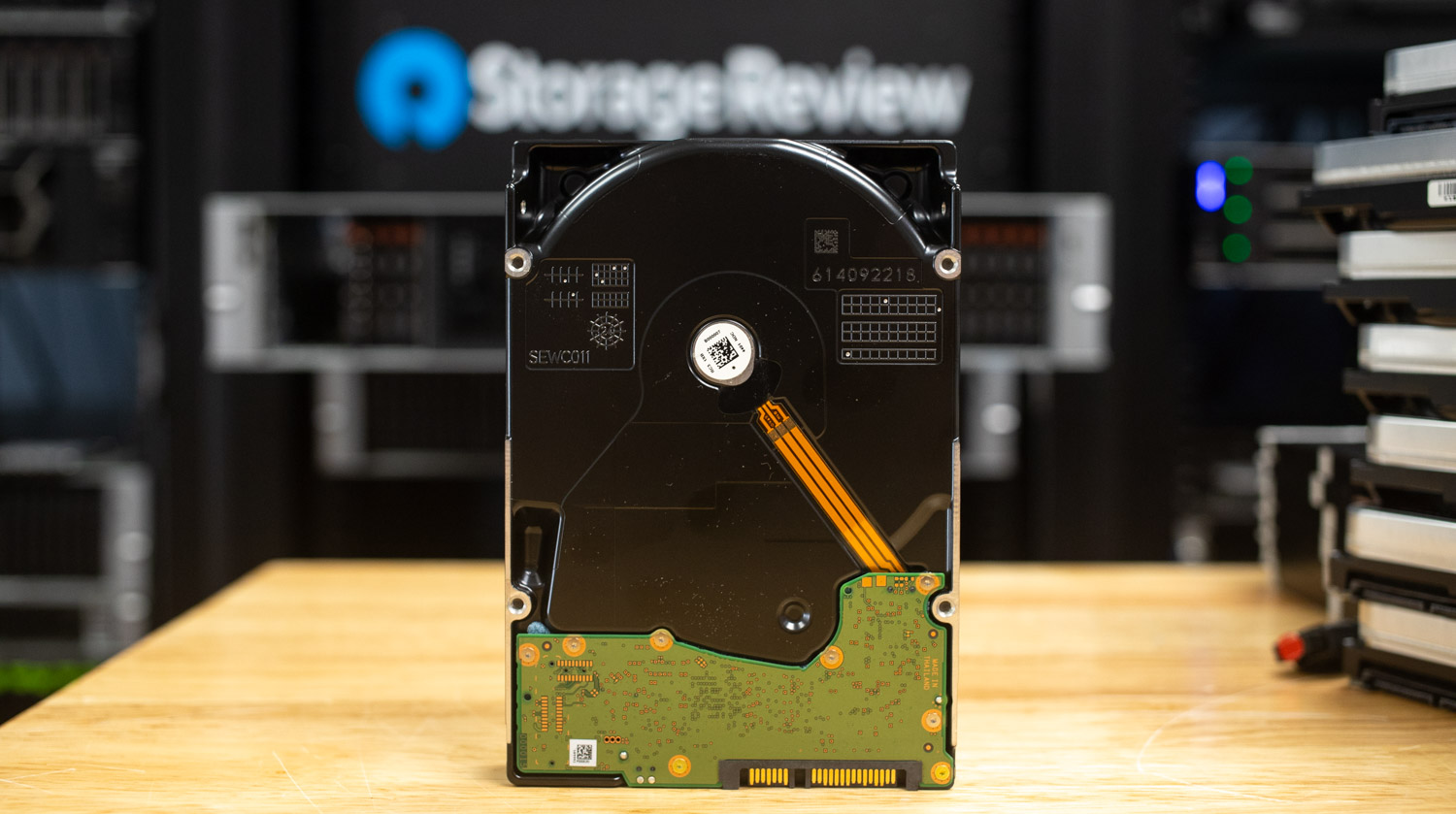
WD Ultrastar DC HC590 26TB Specifications
| Specification | Details |
| Model | WD Ultrastar DC HC590 |
| Capacity | 26TB |
| Form Factor | 3.5-inch |
| Interface | SAS 12Gb/s or SATA 6Gb/s |
| Recording Technology | Conventional Magnetic Recording (CMR) |
| Platter Count | 11 |
| Helium-Sealed | Yes |
| Advanced Technologies | ePMR, OptiNAND, Dynamic Fly Height, Rotational Vibration Safeguard (RVS) |
| Cache Options | ArmorCache: WCE (data protection) / WCD (write performance) |
| Mean Time Between Failures (MTBF) | 2.5 million hours |
| Security Features | Secure Erase (SE) |
| Dimensions (L x W x H) | 5.776″ x 4.000″ x 1.028″ |
| Weight | 1.47 lbs (approx. 667g) |
| Warranty | 5-Year Limited Warranty |
| Model Number | WUH722626AL5204 |
WD Ultrastar DC HC590 Performance
Before diving into the benchmarks, here’s a list of comparable capacity HDDs used to compare the performance of the WD Ultrastar DC HC590 26TB drive.
Here’s the high-performance test rig we used for storage benchmarking:
- CPU: AMD Ryzen 7 9800X3D
- Motherboard: Asus ROG Crosshair X870E Hero
- RAM: G.SKILL Trident Z5 Royal Series DDR5-6000 (2x16GB)
- GPU: NVIDIA GeForce RTX 4090
- OS: Windows 11 Pro, Ubuntu 24.10 Desktop
Peak Synthetic Performance
The FIO test is a flexible and powerful benchmarking tool used to measure the performance of storage devices, including SSDs and HDDs. It evaluates metrics such as bandwidth, IOPS (Input/Output Operations Per Second), and latency under different workloads, like sequential and random read/write operations. This test helps to assess the peak performance of storage systems, making it useful for comparing different devices or configurations. We measured the peak burst performance for this test, limiting the workload to a 10GB footprint on all HDDs.
When comparing the WD DC HC590 26TB to its competitors in our FIO testing, it trailed slightly in sequential performance but remained within a close range. In 128K sequential reads, it reached 268MB/s, which is about 6% behind the Seagate Exos X24 and roughly 5% lower than the WD Gold. Sequential write came in at 280MB/s, just 2% below the WD Gold and closely matched with the Seagate.
In 4K random read, the HC590 delivered 198 IOPS, landing around 7% behind the Seagate and WD Gold. Its 4K random write performance was stronger at 663 IOPS, only 11% off the Seagate, while outperforming the WD Red Pro by over 50% and the WD Gold by nearly 2%.
Overall, the HC590 maintains solid sequential throughput and shows strength in random write performance with only modest differences compared to the other high-capacity drives tested.
| FIO Test (higher MB/s/IOPS is better) | Sequential 128K Read (1T/64Q) | Sequential 128K Write (1T/64Q) | Random 4K Read (16T/32Q) | Random 4K Write (16T/32Q) |
| Seagate x24 24TB | 285MB/s (29.42ms) | 285MB/s (29.42ms) | 210 IOPS (152.03ms) | 749 IOPS (42.70ms) |
| WD Gold 24TB | 283MB/s (29.66ms) | 286MB/s (29.36ms) | 214 IOPS (148.98ms) | 651 IOPS (49.11ms) |
| WD Red Pro 22TB | 271MB/s (31.00ms) | 276MB/s (30.37ms) | 214 IOPS (149.17ms) | 421 IOPS (75.92ms) |
| WD Ultrastar DC HC590 26TB | 268MB/s (31.28ms) | 280MB/s (30.00ms) | 198 IOPS (161.18ms) | 663 IOPS (48.23ms) |
Average LLM Load Time
The Average LLM Load Time test evaluated the load times of three different LLMs: DeepSeek R1 7B, Meta Llama 3.2 11B, and DeepSeek R1 32B. Each model was tested 10 times, and the average load time was calculated. This test measures the drive’s ability to load large language models (LLMs) into memory quickly. LLM load times are crucial for AI-related tasks, particularly for real-time inference and processing large datasets. Faster loading enables the model to process data rapidly, thereby improving AI responsiveness and reducing waiting time.
In the Average LLM Load Time test, the WD Gold 24TB performed the fastest across all three models. For the DeepSeek R1 7B, loading took 46.71 seconds, approximately 2.7% faster than the WD Ultrastar DC HC590, which loaded in 47.99 seconds, and around 4% more rapid than the Seagate x24. On the Meta Llama 3.2 11B Vision model, the Gold posted 68.82 seconds with the HC590 at 71.01 seconds, a difference of roughly 3.2%.
The gap remained consistent with the DeepSeek R1 32B, where the WD Gold led again at 68.97 seconds, followed by the HC590 at 69.79 seconds, and the Seagate x24 further back at 73.81 seconds. Overall, the HC590 was only around 1 to 3% slower than the WD Gold while still outperforming both the Seagate x24 and WD Red Pro in every test.
| Average LLM Load Time (lower is better) | DeepSeek R1 7B | Meta Llama 3.2 11B Vision | DeepSeek R1 32B |
| WD Gold 24TB | 46.7133s | 68.8183s | 68.9720s |
| WD Ultrastar DC HC590 26TB | 47.9877s | 71.0063s | 69.7892s |
| Seagate x24 24TB | 48.6615s | 71.4855s | 73.8097s |
| WD Red Pro 22TB | 49.0575s | 71.4783s | 71.1382s |
3DMark Storage Benchmark
The 3DMark Storage Benchmark tests your SSD or HDD’s gaming performance by measuring tasks like loading games, saving progress, installing game files, and recording gameplay. It evaluates how well your storage handles real-world gaming activities and supports the latest storage technologies for accurate performance insights.
In the 3DMark Storage Benchmark, the Seagate x24 24TB achieved the highest score among the hard drives tested with an overall score of 234. The WD HC590 26TB followed as the second-highest performer at 168, which places it about 12% ahead of the WD Red Pro and another 12% ahead of the WD Gold’s lower 150 score. Compared to the top-scoring Seagate x24, the HC590 came in roughly 28% behind but remained well-positioned in the top end of the pack.
| 3DMark Storage Benchmark (higher is better) | Overall Score |
| Seagate x24 24TB | 234 |
| WD Ultrastar DC HC590 26TB | 168 |
| WD Red Pro 22TB | 156 |
| WD Gold 24TB | 150 |
BlackMagic Disk Speed Test
Blackmagic Disk Speed Test is designed to evaluate a drive’s ability to handle high-resolution video workflows, which are often relevant in media production. The Ultrastar HC590 posted read and write speeds of 267.0MB/s and 264.5MB/s, respectively. These results indicate the drive can support playback and editing of compressed high-resolution formats, but it will not meet the demands of uncompressed RAW workflows. Again, this is within expectations for a 7200 RPM enterprise HDD and is sufficient for media archiving, backup, or offline editing tasks.
In the Blackmagic Disk Speed Test, the WD HC590 26TB showed well-balanced performance with 267.0MB/s read and 264.5MB/s write speeds. While its read speed was just slightly behind the WD Gold and Seagate x24 by around 2%, its write speed stood out as the highest in the group. It outperformed the WD Gold by 24% and the Seagate by a substantial 61% in write performance.
| BlackMagic Disk Speed (MB/s, higher is better) | Read MB/s | Write MB/s |
| WD Gold 24TB | 272.8 | 213.0 |
| Seagate x24 24TB | 271.0 | 164.4 |
| WD Ultrastar DC HC590 26TB | 267.0 | 264.5 |
| WD Red Pro 22TB | 260.9 | 258.3 |
PCMark 10 Storage
PCMark 10 Storage Benchmarks evaluate real-world storage performance using application-based traces. They test system and data drives, measuring bandwidth, access times, and consistency under load. These benchmarks offer practical insights beyond synthetic tests, enabling users to compare modern storage solutions effectively.
In PCMark 10’s Data Drive Benchmark, the WD Ultrastar DC HC590 26TB delivered the strongest performance of the group with an overall score of 853. That’s roughly 27% higher than the Seagate x24 and more than double the scores of both the WD Gold and WD Red Pro, which came in at 397 and 380, respectively.
| PCMark 10 Data Drive (higher is better) | Overall Score |
| WD Ultrastar DC HC590 26TB | 853 |
| Seagate x24 24TB | 671 |
| WD Gold 24TB | 397 |
| WD Red Pro 22TB | 380 |
Conclusion
The Western Digital Ultrastar DC HC590 26TB proves to be a strong contender in the high-capacity enterprise HDD space, offering a thoughtful balance of density, reliability, and real-world performance. Its 11-platter CMR design pushes a new maximum capacity of 26TB in a standard 3.5-inch form factor without requiring changes to existing infrastructure, a key advantage for enterprise and hyperscale environments looking to scale efficiently.’
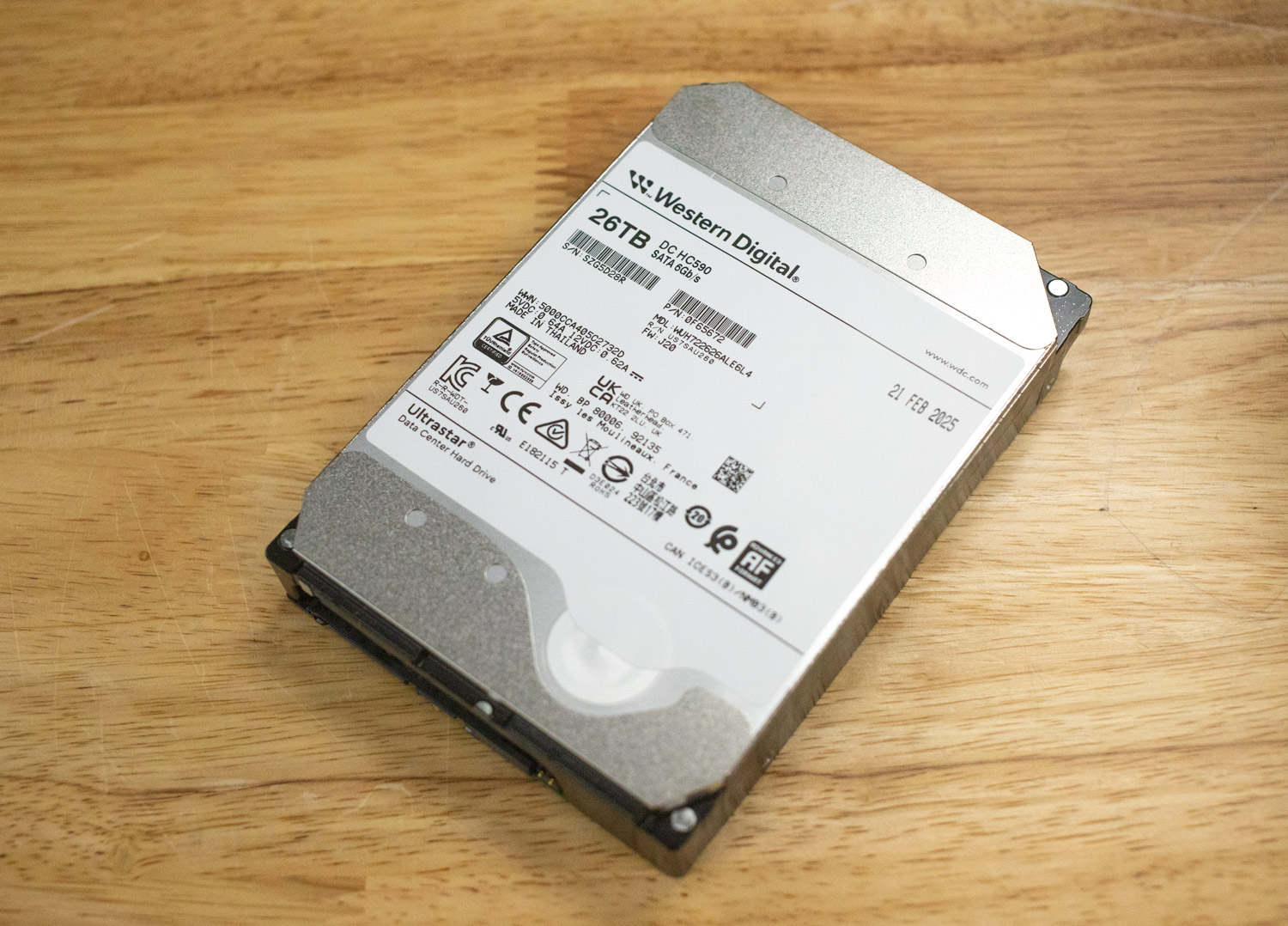
Across our testing suite, the HC590 consistently delivered solid performance. In synthetic benchmarks like FIO, it kept pace with peers in sequential write operations and showed strong random write capability. It also held its ground in application-focused tests, posting competitive LLM load times, leading write speeds in the Blackmagic Disk Speed Test, and securing the top spot in the PCMark 10 Data Drive benchmark. The 3DMark Storage results placed it firmly in the upper tier among tested HDDs, reinforcing its capability in storage-intensive workloads.
Engage with StorageReview
Newsletter | YouTube | Podcast iTunes/Spotify | Instagram | Twitter | TikTok | RSS Feed

